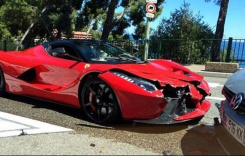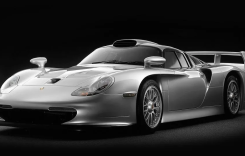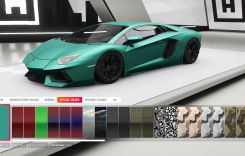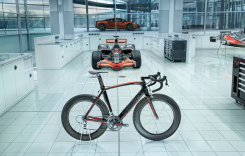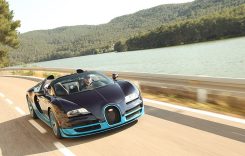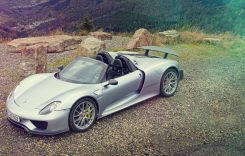Speculation ran rampant as to what direction Polaris would take the Indian Motorcycle Company. Would Polaris carry on tradition, or take it in an entirely different direction altogether? Would a Scout be included in the offerings, or maybe they’d surprise us with something new that paid homage to its racing roots like a 750cc flat tracker. The questions were duly answered when Polaris pulled back the covers on the 2014 Indian Chieftain, Chief Vintage and Chief Classic at Sturgis. While a hard-bagged, hard-faired bagger in the form of the Chieftain was the biggest deviation from the norm, the one bike that held truest to Indian form was the 2014 Vintage. It is imbued with styling cues that made the Indian marque famous, from the deeply valanced fenders to distressed leather seats and tassled saddlebags. On the front fender sits a stoic-faced “Chief” in his light-up “War Bonnet,” the signature trait as recognizable as the script on the tank and the red of the paint. Laced, 60-spoke wheels and a thickly striped whitewall add to its “Vintage” designation.
As classic as the Indian looks, fortunately its performance is 21st century. Ignition is keyless, the standard key replaced by an electronic fob that has to be within proximity of the motorcycle for it to start. The bike drums to life courtesy of an electric starter, roll on the throttle and a ride-by-wire system controls the closed loop fuel injection system and it is equipped with anti-lock brakes. Though its engine sports multi-directional cooling fins, a left-side intake and down-firing exhaust similar to Indian Chief engines from the 1940s, its three camshaft and parallel pushrod arrangement delivers power numbers never before achieved by a stock Indian engine. With the 2014 Indian Chief Vintage, Polaris has done an admirable job of combining the classic and contemporary.

“When I first saw the Indian, photos of it, I really actually wasn’t impressed. It didn’t look that great in photos. But once you get up close to it, it’s a beautiful bike. There’s no getting around it. They really paid attention to every little detail on this bike. Every little thing – the logos, all the castings and the millwork, and the body work and the awesome leather seats and bags that’re old and distressed looking, all of it is spot-on for an American cruiser. You can tell that they really cared about this bike when they built it,” said fellow test rider, Motorcycle USA Editor Justin Dawes.
Climb into its 26-inch high saddle and the Indian Chief Vintage feels long and low. With a total stretch of 103.7 inches, it is a big bike. Its riding position is dictated by long floorboards that are out a bit further and up more than those on the Heritage Softail Classic so a rider’s knees are higher. Its bars are more beach-style, set lower and much wider. The vintage leather seat is a work of art but is scooped at steep angle, so it pushes riders back in the seat. Dawes didn’t like that as a result of this scoop, it locks riders into place and for him, put numbing pressure on his tailbone. On the up side, Indian is already aware of this and the production Chief Vintage motorcycles will feature a slightly different seat.
“You get on the Indian, and it’s got these wider beach bars, it’s real long feeling, it’s real low feeling, and it definitely feels heavier maneuvering at slow speeds. When you’re first pulling out of the parking lot, you’re like ‘whoa, this thing’s quite a bit heavier feeling than the Harley.’ Once on the road, that heaviness goes away a little bit but it does take more effort to get it around corners and muscle it around,” said Dawes.

This is due in part to the bars of the Chief Vintage carrying more weight. Its chrome headlight housing looks fantastic, a ribbed spine running down along its top, but its sheer mass adds heft to the bars. So do the great looking running lights, big steel fender and removable windscreen. The wide bars also have a limited range of motion before physically coming to a stop, giving the Harley an edge when executing U-turns and slow-speed maneuvers. The Indian Chief Vintage doesn’t turn-in or transition as easily either, giving up 90 pounds to its competitor, much of it front-biased.
The disparity in low-speed handling decreases attacking corners at speed though. Contrarily, the big bike stays true to its line in turns, its Dunlop American Elite tires tacky and reliable. Because its floorboards are higher, riders can confidently carry more speed into turns than the Harley and achieve greater lean angles. On the winding SoCal stretch known as Ortega Highway, the Indian Chief Vintage hustles fluidly, never letting the Harley out of its sight. Twist the throttle upon corner exit and its power advantage quickly closes any gaps.
Because the Indian definitely has the Harley covered in the engine department. The difference is notable from the first crack of the throttle as the Chief Vintage surges off the line with arm-wrenching power, the 1811cc mill putting out peak numbers of 100.87 lb-ft @ 2700 rpm and 73.33 hp @ 4500 rpm. As low as 2100 rpm, 94.94 lb-ft of torque is already accessible. After hitting its 2700 rpm peak, another wave of 100 lb-ft midrange muscle quickly follows when it hits 3100 rpm. It beats the Harley in roll-on power and by the time you throw the Indian into sixth gear, the powerful mill is maintaining that speed with little effort. We noticed a difference at redline, too. As the Heritage Softail Classic reaches the parameters of its powerband and signs off abruptly, the Thunder Stroke 111 has a little over-rev so it continues to deliver power even at redline.
“The motor on this thing is very impressive to me. It has a much more gruntier feel than the Heritage Softail did. It just seems, when you gas it, it kinda tugs on your arms, pulls on your shoulders and it pulls out. It’s got a rumble and a lope that when you gas it, you feel it in your chest,” Dawes said.
This isn’t to say that the Indian V-Twin isn’t without it nuances. There’s more valve noise coming from the engine on the Indian, a constant ticking we believe may come from the shape of the valve covers. In congested stop-and-go LA traffic on a warm day, the long-stroking mill with the almost four-inch pistons puts out noticeable heat on a rider’s right calf, too.

Hitting the less-than-smooth thoroughfare known as the 405, similar suspension arrangements between the two cruisers provide comparable ride qualities. While both motorcycles feature traditional forks, the one used on the Indian is a little springier with less travel at 4.7 inches. Both cruisers use a Softail-style arrangement on the rear, albeit the Chief Vintage sources a single rear shock instead of the Harley’s double shock set-up. And while there’s not much disparity in performance of the rear, Dawes and I agreed that the fork is slightly off.
“It seems to have too much rebound, and so you’re going around corners and over bumps and stuff and you get this, it’s not really a hop, but it just comes back through the stroke too fast and has this bouncy feel to it. Going down the freeway in a straight line, when you hit seams and things, the front and the back react at a little bit different speed so you get a teeter-totter, back-and-forth effect when both ends spring back too quickly. If it was a little more cush, a little more slow reacting, that would go away and it’d be a pavement-gobbling machine,” Dawes said.
Once again, we have to include the disclaimer that the Indian Chief Vintage we tested is a pre-production unit. Indian says it is already addressing the issue with the seat, is changing out the floorboard rubbers and has other small details to attend to. Whether one of these details is the spring rates on the fork is unknown at this time.
What is known though is that the 2014 Chief Vintage definitely has the stronger brakes of the two. There’s much better power and feel on the front thanks to big, dual floating rotors teamed to four-piston calipers. Action from the Indian’s single floating rear rotor is comparable to the power and feel of the Harley and will seize with a heavy stab of the pedal before the ABS takes over. That said, the ABS on the Indian is less intrusive and the pulse rate is different so it doesn’t kick back in the ball of a rider’s foot as aggressively as the system on the Harley.
“Braking power from the front brake on the Indian is far superior to the Harley. It’s got good feel, a nice lever pull, and doesn’t take too much effort. The rear brake doesn’t have so much feel. The ABS locks and lets off, you can lock it and slide it, half-second pulses. Up front, it’s really difficult to get it into the anti-lock,” added Dawes.
On the form and functionality side, Motorcycle USA’s tester Justin Dawes already commented on how Indian has paid an admirable amount of attention to details. Its chrome, tank-mounted console features a large analog speedo with a digital window that reads out gear position, dual tripmeters, and digital tachometer. The console also includes a small round dial for the fuel gauge. The instruments on the Indian are mounted higher and slanted more toward the rider making them easier to see than the cluster on the Harley. Cruise control is a standard feature the Chief Vintage has that the Heritage Softail Classic doesn’t. The system is push-button activated via switches in the right control housing, the system operable even with gloved fingers. Like the Harley, the Chief Vintage also has a removable windshield, albeit the one on the Indian is a bit taller. It offers first-rate wind protection, but Dawes commented that he was getting a reflection off the “awesome looking dash” in the windshield.
“You have these kind of lines and flares in the windshield all the time, especially noticeable when you go from light to dark on country roads,” he said.
Being a little bit taller than Dawes, my line of sight is higher and the reflections he mentioned weren’t an issue for me. But both he and Jason Abbott, who tested the Chief Vintage for Cycle News and is about the same size as Dawes, mentioned it so we thought it a valid enough point to comment on. Its saddlebags have the same high quality leather workmanship as the seat and are a tad wider than the ones on the Harley. Metal clasps are a sweet accent, but like the ones on the Heritage Softail Classic, the bags don’t lock.

As noted in our introduction, we thought the two American cruiser motorcycles would be carbon copies of one another. But they’re not. The Harley sports a more compact rider’s triangle, feels like a much smaller bike than it is, and enjoys an advantage in low-speed handling. The Indian on the other hand is long, low, and feels large and in charge. Riders are sprawled out more, from the stretch to the floorboards to the reach to the bars. After spending time on both bikes, it is a hard one to judge. The Heritage Softail Classic is easier to ride, its suspension is dialed in better, and its gearbox is just a tad more refined. Bottom line though, the Indian Chief Vintage stops and goes better. The pop of its Thunder Stroke engine makes you drunk with power. Its binders on the front are much more powerful while its ABS is less intrusive. While the Harley has lighter steering at low speeds, it also grinds boards much easier than the Indian and sacrifices lean angle at speed as a result. The Heritage Softail has the better fork, but ride quality on the backside is almost identical. The differences between the gearboxes are minute, and Indian has said it is already addressing Dawes’ issue with the seat. Overall, we believe the Harley’s soft front brakes and monotone power delivery are a bigger trade-off than the fast rebounding fork and heavier steering of the Indian. Having 18.36 lb-ft more torque to play with and faster-reacting roll-on also tilts the scales in favor of the 2014 Chief Vintage. Indian’s marketing strategy declared that “Choice is Here” for people who want an American cruiser motorcycle. We say buyers do indeed have a choice now in high quality American cruisers as the flames of a 100-year-old rivalry are once again ignited.

